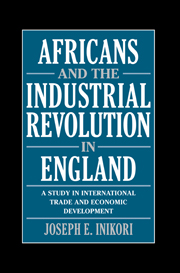 Africans and the Industrial Revolution in England
Africans and the Industrial Revolution in England Published online by Cambridge University Press: 23 December 2009
THE COURSE AND NATURE of the almost 800-year-long development process in England, which produced the structural and technological transformation controversially referred to as the Industrial Revolution, have been carefully laid out in the preceding chapter. The task now is to show how historians have explained the causes of this major historical event. Since the first systematic study by Arnold Toynbee in the 1880s, economic historians have periodically taken stock of the state of knowledge in the field. One of the earliest such exercise was by T. S. Ashton in 1937, in which we are informed that those who taught economic history before World War I “had but a meagre shelf from which to make up our story of the Industrial Revolution.” Between the wars the literature grew quickly. Ashton was, therefore, able to report excitedly, just before World War II, that the problem for students of the Industrial Revolution was “no longer a question of finding raiment to cover intellectual nakedness, but of which many garments to assume.” The literature on the subject has grown continuously since then. In 1965, Max Hartwell published the first “reasonably comprehensive and critical survey” of the various attempts by economic historians to explain the causes of the Industrial Revolution. The latter work presents a critical discussion of the different explanations favored by scholars. Since that publication, similar critical surveys of the literature on the causes of the Industrial Revolution have been published, the most recent and probably the most comprehensive being the one by Joel Mokyr.
To save this book to your Kindle, first ensure no-reply@cambridge.org is added to your Approved Personal Document E-mail List under your Personal Document Settings on the Manage Your Content and Devices page of your Amazon account. Then enter the ‘name’ part of your Kindle email address below. Find out more about saving to your Kindle.
Note you can select to save to either the @free.kindle.com or @kindle.com variations. ‘@free.kindle.com’ emails are free but can only be saved to your device when it is connected to wi-fi. ‘@kindle.com’ emails can be delivered even when you are not connected to wi-fi, but note that service fees apply.
Find out more about the Kindle Personal Document Service.
To save content items to your account, please confirm that you agree to abide by our usage policies. If this is the first time you use this feature, you will be asked to authorise Cambridge Core to connect with your account. Find out more about saving content to Dropbox.
To save content items to your account, please confirm that you agree to abide by our usage policies. If this is the first time you use this feature, you will be asked to authorise Cambridge Core to connect with your account. Find out more about saving content to Google Drive.